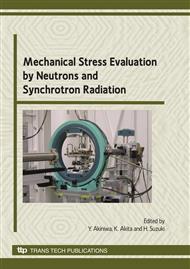p.260
p.266
p.270
p.275
p.279
p.285
p.290
p.296
p.303
Evolution of Residual Stresses and Stored Elastic Energy in Ferritic Steel during Recovery Process
Abstract:
Diffraction method was applied to determine the residual stresses in deformed and annealed polycrystalline samples of ferritic steel. The specific stored elastic energy corresponding to the grain stresses was calculated and presented in Euler space. An important decrease of the first and second order residual stresses and consequently stored elastic energy was observed during recovery and recrystallization. The evolution of stresses was correlated with the variation of diffraction peak width (related to dislocations density) and crystallographical texture.
Info:
Periodical:
Pages:
279-284
Citation:
Online since:
May 2010
Price:
Сopyright:
© 2010 Trans Tech Publications Ltd. All Rights Reserved
Share:
Citation:


